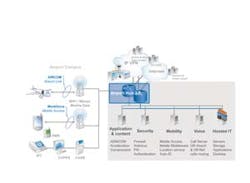BRUSSELS — The Air Transport IT Summit held here in Belgium last month provided an opportunity for the industry’s tech specialists to address an increasingly digitized world, and to discuss what that means for the future of passenger air travel. Key takeaways from this year’s summit include cost savings, collaborative decisionmaking, virtualized IT environments, and stakeholder integration. In our August issue, AIRPORT BUSINESS will report in-depth on the summit’s industry sessions, and on the ‘digital airport’ of the future.
SITA, specialists in air transport communications and IT solutions, says server virtualization will be the mainstay of data center design within five years. Virtualization works by splitting a physical server into separate partitions, creating virtual servers with the capability of running applications in isolation from other partitions. The result is that multiple applications can be run seamlessly on a single piece of physical hardware, enabling higher utilization rates with fewer physical servers.
In effect, virtualization better matches computing capacity with load, says SITA, allowing a much more efficient use of IT investments.
The Air Transport IT Summit, managed and hosted by SITA, proved to be an effective forum for the industry’s IT leaders to identify the best use of IT investment across the airport setting.
In a presentation given by SITA’s senior product manager Benoit Verbaere, airports are identified as ‘keen to provide standard services to tenants.’ Virtualization, says Verbaere, enables infrastructure multitenancy, and touches all layers of information and communication technology (ICT).
According to Verbaere, a robust multi-tenant community IT plaform needs include:
• On demand, elastic CPU, memory, storage, and connectivity; and
• Secure, pre-connected (LAN, IP VPN, Internet).
A multi-purpose infrastructure will support:
• Airline applications required to run locally at an airport, e.g. aircraft servers; process and business specific applications; and content;
• Utility services like DNS, DHCP, file, security, email;
• Application integration, aggregating various data feeds, combined with business intelligence;
• Hosting of virtual desktop;
The “as a service” community model provides:
• Footprint reduction and cost avoidance for IT resources;
• Ease of entry and ease of scaling up/down; and
• Management, automation, and chargeback.
The air transport industry is innovating and building digital airports, relates Verbaere. However, best practices are needed to expedite availability, or to do more within a capped IT budget, and to facilitate local cross-boundary collaboration.
SITA innovation focus groups will provide a forum for the development of new air transport industry solutions that focus on business operations and business process transformation requirements, he says. Focus group priorities include the design of a joint airline/airport approach, pilot programs, and proofs of concept.
Airline IT trends
The 2010 Airline IT Trends Survey, co-sponsored by Airline Business Magazine and SITA and published during the IT summit event, received a record 129 airline respondents this year.
Highlights include:
• Overall operating IT and IT spending will remain at about 1.8 percent of total airline revenues for 2010, but 90 percent expect IT budgets to remain the same or increase next year;
• Airlines expect tickets sold through their own direct channels to grow from 25 percent to 37.9 percent by 2013;
• Airline ability to sell tickets through mobile phones is expected to grow from 18 percent today to 70 percent by 2013.
According to the survey, mobile phone services will play an important role in the evolution of self-service technologies, evolving from a passenger communication-focused channel to a more interaction/transaction driven interface to the passenger.
Airlines expect more than 12 percent of passengers using mobile phones to check-in by 2013, up from only 2 percent today.
Book Flights Using the iPad
A World First — Malaysia Airlines and SITA have launched a kiosk to sell airline tickets using the Apple iPad in Kuala Lumpur.
Says Malaysia Airlines managing director Tengku Dato’ Azmil Zahruddin, “There is a huge interest in the iPad MHkiosks ... it will mean better queue management at our ticket offices during peak hours when customers can be re-directed to ‘stand-alone’ iPad MHkiosks.”
Jim Peters, the SITA chief technology officer that heads the SITA Lab facility which worked with Malaysia Airlines on development, says SITA regards the innovation as a significant breakthrough for the airline industry which is seeking to provide the online public with additional sales channels and attractive functionality.
The annual 2010 Airline IT Trends Survey, conducted by SITA and Airline Business Magazine, seemed to confirm Peters’ remarks. Survey results, published during the Air Transport IT Summit event, indicate that airlines are prioritizing the implementation of new functionality on their websites with online shopping tools; change, cancel, and rebook fuctionality; and frequent flyer redemption functionality.
In addition, of the 129 airlines (81 percent full-service; 14 percent low-cost; 5 percent charter carriers) who responded to the survey, 56 percent expect an increase in IT investment during the next year. According to SITA, the survey confirms a strong ambition among airlines to implement virtualization technologies, with the initial priority on IT infrastructure — 40 percent of respondents have already created a virtual environment, and that is expected to rise to 85 percent by 2013. Software and desktop virtualization are the next steps in the transition.
About the Author

